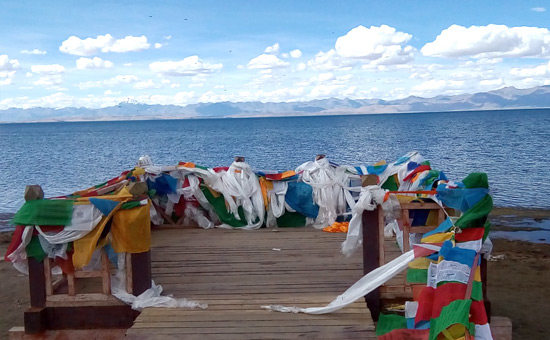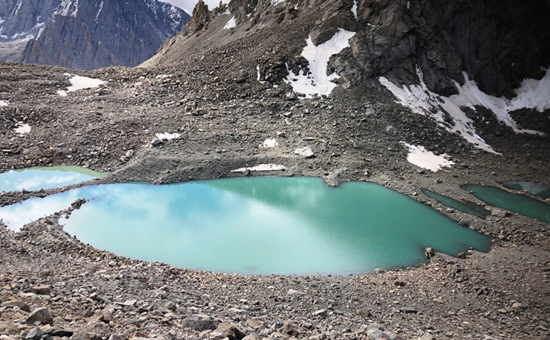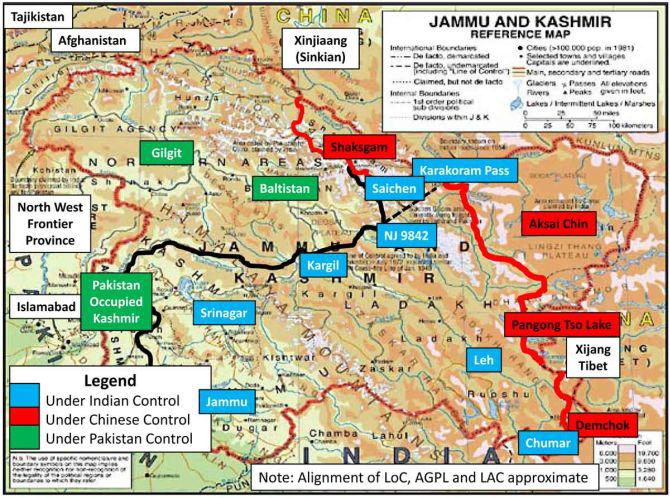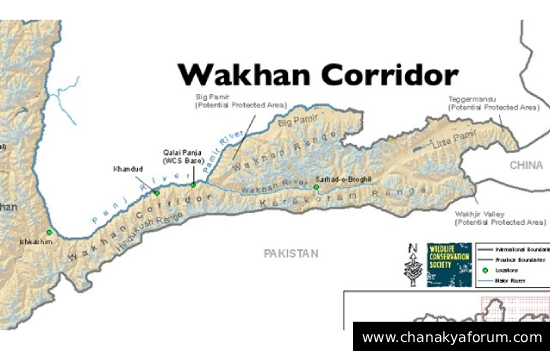- Article
proposes a partial solution to the India China Border problem and includes why Akshai
Chin is important for China and why Mount Kailash is important for Bharat?
Former
Ambassador P Stobdan, who hails from Ladakh, wrote in Tribune Chandigarh, “People barely know that India legally owned a territorial estate, Menser, deep inside Tibet at Mt Kailash until the 1960s. It was the only land that Ladakh’s king retained after having lost half of Ladakh-extending up to Rudok and Nepal junction-to the Tibetan-Qing invaders in 1683.”
It is also known that Maharaja Hari Singh signed the Instrument of Accession on October 26, 1947 as ‘Shriman Inder Mahinder Rajrajeswar Maharajadhiraj Shri Hari Singhji, Jammu & Kashmir Naresh Tatha Tibbet adi Deshadhipati’ meaning “that he is also the ruler of western Tibet.” Source
The Ambass also wrote, “If India was competent to take up Bhutan’s territorial rights in Tibet, what prevented it from raising Ladakhi rights in Tibet with Beijing? If surrendering land of J&K wasn’t approved by Srinagar, does that mean that Menser still remains an open-ended issue?” Must read article
Since
border settlement is once again being spoken about, access to Mount Kailash needs
to be restored Read The
Indian Village in Tibet by Claude Arpi
But, why is Mount Kailash important for India?
Mount
Kailash is worshipped by Hindus, Buddhists and Jains. It is considered the
abode of Lord Shiva who is worshipped across India-from Tamil Nadu to Kashmir
and Gujarat to Arunachal.
Rinchen
Wangchuk wrote in BetterIndia.com, “For Buddhists, any pilgrimage to Kailash-Mansarovar is incomplete without a stop at Tirthapuri in Western Tibet, which is the third most important Buddhist pilgrimage site following Mount Kailash and Lake Mansarovar. “The main sacred structure in this temple (Tirthapuri monastery) is a statue of Guru Padmasambhava (an 8th-century Buddhist master known as the historical founder of Buddhism in Tibet),” writes Sonam Wangchuk.” The monk for Tirthapuri monastery earlier came from Hemis Monastery, Leh.
For Jains it is where the first Jain Tirthankara Rishabhdeva attained liberation from rebirth. Tibetan Buddhists “believe that Kailash is the home of the Buddha Demchok (also known as Demchog or Chakrasamvara), who represents supreme bliss.”
In
Kailasa rock-cut cave Ellora, (elsewhere too) there are numerous sculptures of
Shiva and Parvati sitting on Mount Kailash. To see Kailasa Ellora
album
When
I did the Kailash Mansrovar Yatra in 1998, Saivites, Jains, Nepali &
Tibetan Buddhists simultaneously offered Pranams to Mount Kailash when we first
saw it. It was this that united us at a deeper and spiritual level. In fact, my
Jain fellow yatri wore their marriage dress and did puja on the banks of the Mansrovar.
Read Co-existence of
Hindu, Buddhist, Jain pilgrimages/monuments
 Mansrovar.
Pranams.
Mansrovar.
Pranams.
How can one access Mount Kailash from Ladakh?
Ladakh
is the shortest and safest route to Mount Kailash.
In
2018 Rinchen Wangchuk wrote
in BetterIndia.com, “The 633-km route from Leh to Tarchen-Parakha (basecamp for Mount Kailash) can be covered in just two days. From Demchok (approximately 237 km from Leh) onwards, the motorable road to these holy sites does not traverse through any major passes, remains free from the risk of avalanches.
In the biography of Kushok Bakula Rinpoche, author Sonam Wangchuk details the pilgrimage he made to Kailash-Mansarovar in the summer of 1954, before the Chinese annexation of Tibet. He crossed on horseback Taglang-La, a high mountain pass perched at an altitude of 17,480 feet, before passing through the picturesque Changthang plateau (home to the Changpa nomads and Pashmina goats), and finally entering into what is today China-occupied Tibet.”
I spoke to a tourist guide in Leh today who told me that the road from Leh to Demchok has improved – takes 8 to 9 hours.
Rinchen also wrote, “From Demchok, the entourage made their first stop at Tashigang town in Western Tibet. Tashigang is now on the Western Highway, which connects Tibet to the Xinjiang Province.” It is also called the Xinjiang Tibet Highway, part of it passes through Akshai Chin. The area was part of the Instrument of Accession signed by Maharaja Hari Singh in 1947.
 Gauri Kund enroute Mount Kailash parikrama.
Gauri Kund enroute Mount Kailash parikrama.
Why is Akshai Chin important for China?
The
Sinkiang and Tibet plateaus constituted a wedge into the Himalayas and were
considered by China to be a bulwark against communist influence in Asia. They
wanted to grab those areas that allowed it to establish roads between Sinkiang
and Tibet. With the undetermined border between Soviet Turkestan and Sinkiang a
source of friction and the tension with Russia, China needed an effective line
of communication with Sinkiang through Akshai Chin.
Lt
Gen N S Malik (retd) wrote in Indian Defence Review, ‘China is spending huge sums to build infrastructure through highways connecting Tibet to Xinjiang through the Chinese occupied Akshai Chin plateau, and Xinjiang to Pakistan via the Karakorum highway through the Kunzreb pass. This highway then connects Gwadar port on the Arabian Sea, giving warm water port and access to the Indian Ocean to China. Its importance can be visualized in that China trade can avoid the bottleneck of Malacca straits as also cuts down turn round to the interior provinces of China.’ See map.
 Courtesy University of Texas.
Courtesy University of Texas.
First, what is the area illegally occupied by China and
Pakistan?
Pakistan
occupies 35% and China 19% of the area ceded to India under the Instrument of
Accession. Of the 19%, 5180 sq kms i.e. Shaksgam Valley was ceded by Pakistan
to China in 1963 (area is very close to Siachen Glacier). India and China must
focus on area forcefully occupied by China 37,555 kms.
|
Regions
|
Sq Kms*
|
% of Total Area
|
|
1. Indian State of Jammu and Kashmir
|
1,01,387
|
46
|
|
2. Pakistan Occupied J&K (Mirzapur etc
13,297sqkms, Gilgit Baltistan 64,817sqkms)
|
78,114
|
35
|
|
3. Ceded by Pakistan to China in 1963.
|
5,180
|
2
|
|
4. Forceful occupation by China
|
37,555
|
17
|
|
Area covered by Instrument of Accession
|
2,22,236
|
100
|
*Source - https://globalcitizenjourney.org/about-india/about-kashmir/
Proposal by Lt
Gen P R Shankar (retd) to solve border with China
1.
India must agree to a major compromise by allowing China legitimate access to
Western Express Highway that passes through Aksai Chin.
2.
In return, China gives up its claim on Arunachal Pradesh completely and
3.
Vacate Gilgit Baltistan. To visit his U Tube channel
China’s claim on Arunachal Pradesh is weak so if it wishes to improve relations with India it needs to give up its claim. To see over 600
pics of Arunachal by me
 Cute kids at Ramakrishna Mission School, Deomali, Arunachal Pradesh.
Cute kids at Ramakrishna Mission School, Deomali, Arunachal Pradesh.
This will leave the Dalai Lama/Tibet/Akshai Chin questions. Let us leave this to the future to decide. If the Chinese are insecure about Tibet, India cannot do much. Given China’s investments in Gilgit / Baltistan and Gwadar Port, China is unlikely to agree to vacating GB. India has to wait for a popular uprising.
India must assure China that at some point if India re-occupies parts of Gilgit/Baltistan and consequently shares a border with Afghanistan’s Wakan Corridor, it shall not disturb China’s access to Afghanistan.
 Wakan corridor that connects China with Afghanistan.
Wakan corridor that connects China with Afghanistan.
Proposal for access to Mount Kailash and legitimising Western
Highway that passes through Akshai Chi
Suggestions 1 and 2 made by Gen Shankar are bang on. China will never cavate GB. Further, China must allow road access via a pre-determined route from Ladakh (Demchok or equivalent route) to Kailash Mansrovar and restoration over Menser as stated by Ambass P Stobdan. To start with there could be joint-patrolling. This move shall attract more tourists to Ladakh.
Tibetans and others shall have access to Kailash Mansrovar as they have today.
If
the Chinese feel they are being generous, they could treat this deal as
repayments of past contributions by Bharat. Read Ayurveda Influence
on Traditional Chinese Medicine and Chinese New Year – The Indian Connection
and Indology in China
Let India and China take small steps and leave the rest to the future. If this works well, it shall build trust between the two nations and might lead to a brighter collective future.
At
no stage must India let its guard down with China and overlook its support to
Pakistan and Bangladesh amongst others. India will find its own place in the
world based on its civilizational values and true nature. As a fellow
civilizational country, China should be more secure.
Also read
1.
Articles by Ambass
P Stobdan
2.
Tibet is at the
heart of the India China dispute
3.
How did China
become such a big country
4.
China did not ever
enjoy cultural or military supremacy in Asia
5.
What stops me from
loving Pakistan
6.
China and
Afghanistan jostling over Wakan corridor
7.
LAC and Ladakh
8.
Why was Pakistan planning to capture Wakhan by P Stobdan – “Wakhan is going to be part of Pakistan’s new intrigue, which could have unanticipated consequences. Gilgit-Baltistan, which borders the Wakhan Corridor, belongs to India; hence, New Delhi cannot remain a bystander. Currently, the Durand Line is not a mutually acknowledged border. India should question the legitimacy of the Durand Line Treaty, which expired in 1993. The treaty envisaged Khyber Pakhtunkhwa’s return to Afghanistan, analogous to Hong Kong’s return to China in 1997.”